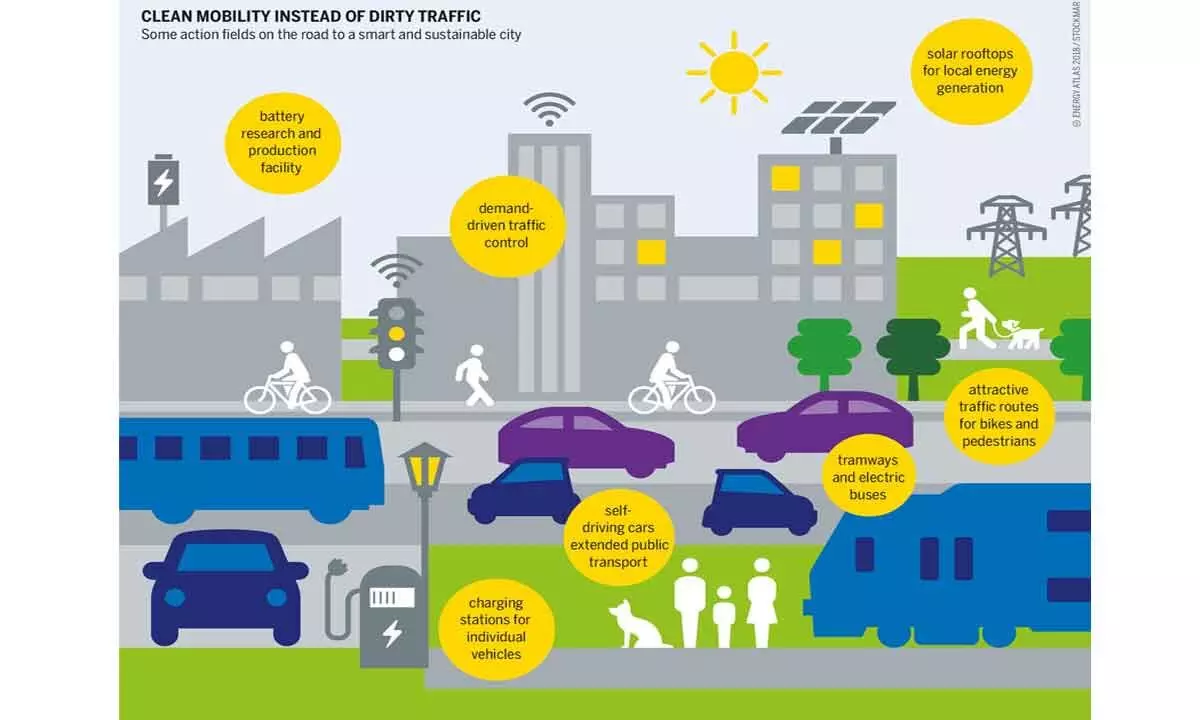Sustainable transportation poised to rewrite urban landscape this year
India, the world’s third-largest automobile market, is transforming urban transportation
image for illustrative purpose

Over the last nine years, India's operational metro lines surged from 248 km in 2014 to 905 km across 20 cities. Presently, the country boasts of the world's third-largest metro network, with plans to surpass the USA's operational length, securing the second position within the next two to three years
The year 2024 promises to be a milestone one in the pursuit of sustainable urban living, with innovative technologies, smart infrastructure and eco-conscious initiatives reshaping the way we move within our cities. It is time to explore what sustainable urban mobility will look like this year and how these changes are poised to create more efficient, greener and people-centric urban environments.
One of the most significant shifts in urban mobility is the widespread adoption of electric vehicles and integration of autonomous driving technologies. The cities are expected to have extensive electric charging infrastructure, making it convenient for residents to transition from ICE (internal combustion engines) to EVs.
Q-Park is leading the way with their current rollout of EV charging points across the country. Both governments and private entities are likely to offer incentives to promote the purchase of electric vehicles, reducing the carbon footprint of urban transportation.
India, as the world’s third-largest automobile market, is at the forefront of a substantial transformation in urban transportation. This evolution is crucial for addressing the challenges of urbanization while embracing sustainable and efficient transport solutions.
Urban transportation refers to the diverse modes of movement within cities, each playing a pivotal role in our daily lives. It includes vital lifelines like buses, metros, trams and trains, and effectively reduces the need for individual vehicle ownership. Private vehicles, such as cars, motorcycles, and bicycles, contribute to individual mobility, underscoring the importance of traffic management and adequate parking facilities. Walking and cycling paths promote healthy and sustainable travel, while shared services like ride-sharing and bike-sharing programs contribute to congestion alleviation. The physical infrastructure, comprising roads, bridges, tunnels and transit stations, forms the backbone of urban transportation, complemented by technology like Intelligent Transportation Systems (ITS) and real-time information systems.
Over the last nine years, India's operational metro lines surged from 248 km in 2014 to 905 km across 20 cities. Presently, the country boasts of the world's third-largest metro network, with plans to surpass the USA's operational length, securing the second position within the next two to three years.
The Union government has spearheaded initiatives to shape the future of urban transportation. The Faster Adoption and Manufacturing of Hybrid and Electric Vehicles (FAME-I and FAME-II) schemes incentivize electric and hybrid vehicles, with a specific focus on electrifying public transportation, including buses.
Launched on August 16, 2023, the PM-eBus Sewa scheme aims to revolutionize public transportation by deploying 10,000 electric buses in cities without existing bus services. This scheme, committed to sustainability, defines an e-bus as one powered exclusively by zero-emission electricity. This ambitious initiative unfolds in two strategic segments. In 169 cities, a public-private partnership (PPP) model facilitates the deployment of 10,000 e-buses, fostering collaboration between the government and private entities. Simultaneously, 181 other cities undergo infrastructure upgrades under the green urban mobility initiatives, ensuring a holistic transformation of the urban transportation landscape.
Urban transportation confronts challenges like congestion, pollution, safety concerns, last-mile connectivity, infrastructure needs, and public transport capacity limitations. Ongoing efforts are aimed at tackling these challenges through improved traffic management systems, alternative transportation modes, the adoption of electric vehicles, and the creation of pedestrian-friendly zones. The journey toward sustainable and efficient urban transportation in India is on a promising trajectory, balancing growth with environmental and social considerations.
The future of transportation isn't just about speed and convenience but about saving the planet. On that count, 2024 is the year when we need to ditch gas guzzlers and embrace the eco-friendly groove. Imagine charging stations sprouting up like wildflowers, electric cars sharing rides to reduce emissions, and bikes that generate power as you pedal!
Cities will transform into green oases, with parks carved into abandoned highways, self-driving shuttles powered by sunshine, and streets humming with the gentle whir of electric scooters. Buckle up for a future where sustainability isn't just a buzzword, it's the rhythm of the road.
By and large, 2024 will rewrite urban landscape. Get ready for walkable streets lined with vibrant cafes, where electric scooters zip past chattering pedestrians. Picture bikes gliding along dedicated lanes, weaving through parks that have replaced abandoned parking lots. And for those lazy afternoons, self-driving shuttles will whisk you to hidden corners of your city, revealing secret gardens and rooftop bars you never knew existed. Buckle up for a future where your city becomes your playground and every corner an adventure waiting to happen.

